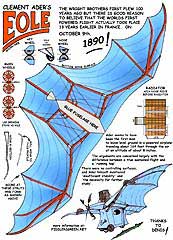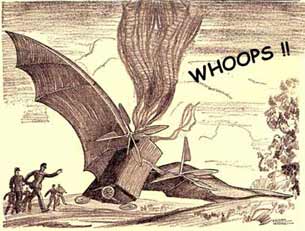



Eole Flying Machine - $$4.95
Unlike many early flying machines, Clement Ader's Éole did not attempt to fly by flapping its wings, but was to rely on the lift generated by its wings (mechanical copies of bat wings). Its steam engine was an unusually light weight design and drove a propeller at the front of the aircraft. Cardmodel kit includes A FREE stick model plan of the Eole !!
Clement Ader's Eole early Flying Machine

This original artwork that's suitable for framing is available with the Full Collection DVD.

In the entire history of aviation, there is no more controversial figure than Clement Ader and his Eole. Even today arguments persist concerning the Frenchman's achievements and the influence on aeronautical progress. In many circles, it is now generally admitted that Ader was the first man to leave level ground in a powered aeroplane at Chateau Pereire at Armainvilliers traveling about 164 feet through the air at a height of about 8 inches above the ground.
This gem of a model was created by our Brit friend from Norfolk, Derek Roberts..
It fits in perfectly with our ..Early Flying Machine Series
You know, putting together a dozen of these kits back-to-backin quick succession has been its own tremendous tutorial in paper model design. Simply by folding and forming single sheets into subtle fuselage forms (I'm thinking of the Gee Bee R1, the Sopwith Camel and the Warhawk) I realized how to solve a longstanding problem of how to coax ONE PIECE of paper into both a convex and concave leaf form. Thanks, guys!
In music and in art, the protocol for learning the craft has always been "imitate, assimilate, innovate."That's proven true, once again, these past few weeks. KB
 |
 Thanks to Dave Finkleman |
 |
 |
 Adding another layer of 'wood' support structure cut from thick card stock. Easy. Here are three in-process snap shots of the FG EOLE. Bob Penikas |
|
Clement Adler's early flying machine, Eole
In a Paris museum stands the remarkable invention of Clement Adler which has been immortalized by the French nation as the first airplane to carry a human being into the air. Opinion differs, however, as to its success.
An eminent engineer, Adler, began his experiments in aviation in 1872 on a flapping wing machine which failed because a man didn't have the strength to operate it. Turning his attention in 1886 to the fixed-wing type of airplane run by steam engines, he built three machines. His work and demonstrations were kept in deepest secrecy.
Some maintain that the inventor of the first heavier-than-air vehicle to get off the ground was Clement Ader, an engineer from Toulouse who, at the age of 49, built his first flying machine, the Eole. which he tested in October 9, 1890, claiming the flight was crowned in success. The Eole actually lifted only a short distance from the ground. Heartened by the, result, Ader had been substantially funded by the French government to research whether the craft could lift off the ground and cover a given distance, and he himself invested all he had in the construction of the Avion III which he presented before the French Ministry on October 14. 1897.
What happened on that foggy October day was that the plane did not fly a yard. After the experiment, the War Ministry abandoned Ader to his destiny. Among other factors the French engineer, like so many others, was betrayed by its engines, which were too heavy and too weak to lift the Avion III off the ground.
Unsatisfied with the results of his first plane 'Ecole", he built two more. One, the 'Avion' was powered with TWO very well engineered 20-horsepower steam engines. The machine was mounted on a three wheeled landing rear and had a wingspan of an incredible 52 feet 6 inches.
The 'Avion' was demonstrated before a group of French military officers and according to the inventor and some of the witnesses, the 'Avion' actually took off the ground, but fearing a collision with nearby obstacles, Adler cut off the steam and the machine was wrecked.
|
The Eole flew, but not as high as this illustration from 1891 suggests. It climbed to eight inches for 165 feet, but lacked good flight control. |

In the entire history of aviation, there is no more controversial figure than Clement Ader. Even today arguments persist concerning the Frenchman's achievements and the influence on aeronautical progress. In many circles, it is now generally admitted that Ader was the first man to leave level ground in a powered aeroplane at Chateau Pereire at Armainvilliers traveling about 164 feet through the air at a height of about 8 inches above the ground.
The arguments remaining are concerned largely with the difference between a true sustained flight and a 'running hop'. Ader was an electrical engineer and inventor, and his name endures in history not only for his pioneering flight, or hop, which he claimed to have made in secret on 9 October 1890, but for his work in developing the telephone. The aircraft he used on the date given was called the Eole, and was the outcome of much earlier experiment, for Ader had publicly exhibited his first large model aeroplane in 1874. In appearance the Eole was like a bat, and it was powered by a steam engine which drove a tractor, or front-mounted, propeller. The wings were arranged to fold, as on modern naval machines used from aircraft carriers, but there were no controlling surfaces, and Ader himself mentioned 'insufficient stability' and 'the necessity for further study'.
A second machine, called the Avion, was never completed.. but it gave the French their accepted name for an aeroplane. Its successor, the Avion III, was tested on two occasions late in 1897; but there is no real evidence to support the claims of Ader, made in later years, that this succeeded in becoming airborne. The most remarkable feature of this third machine was that it had two engines.
Ader foresaw clearly the military uses of airplanes and the French military authorities gave him financial assistance. When this was withdrawn, and after Ader had spent his entire fortune, all work ceased. He destroyed the Ecole, sadly, but the Avion III and its remarkable steam engines survive.
The first machine ever to leave the
ground under its own power was built by Clement Adler. A distinguished
electrical engineer, Adler got the flying bug and in 1882 he started
construction of a flying machine. The result was a bat-like monoplane
driven by an exceptionally-light steam engine. In a test on October
9th, 1890, Adler apparently was able to get the machine, which
he had named "The Eole," to raise itself above the ground
some eight inches for a distance of 165 feet. But like Maxim's,
Adler's machine lacked control and was incapable of sustained
flight. Later attempts by Adler to build a more sophisticated
flying machine for the French military failed, though Adler later
was to claim he'd made flights with it as high as 1,000 feet.
|
Specifications for Clement Ader's Eole Flying Machine
 |
Length: 21 ft 4 in |







